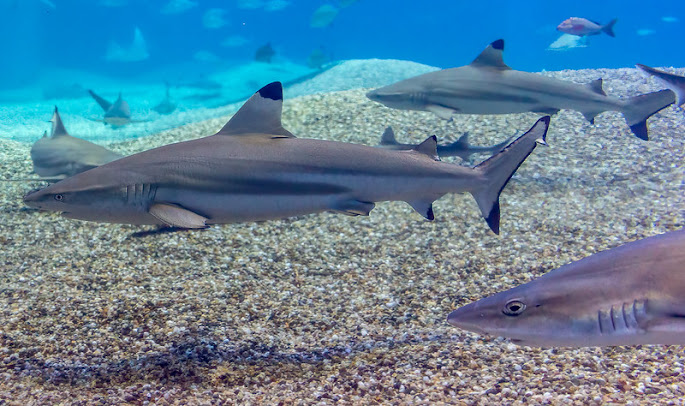In the azure waters of our planet's oceans, a sleek and powerful predator rules—the Blacktip Shark. This comprehensive article dives deep into the world of the Blacktip Shark, exploring its taxonomy, appearance, habitat, behavior, and its vital role in marine ecosystems.
Taxonomy and Classification
To understand the Blacktip Shark, we must begin with its taxonomical classification. Scientifically known as Carcharhinus limbatus, it belongs to the family Carcharhinidae, a group commonly referred to as requiem sharks. These sharks are characterized by their streamlined bodies and wide distribution in tropical and subtropical waters.
Appearance and Characteristics
Striking Black Tips
The Blacktip Shark derives its name from the distinctive black markings on the tips of its fins, most notably the dorsal fin. These markings provide a striking contrast against its otherwise grayish or bronze-colored body, making it easily recognizable.
Size and Sleek Design
Adult Blacktip Sharks typically measure between 5 to 6.5 feet in length, with males being slightly smaller than females. They have a sleek and streamlined body, which aids in their agility and speed as they navigate through the ocean.
Habitat and Range
Blacktip Sharks are highly adaptable and can be found in a wide range of marine environments. They prefer warm, tropical and subtropical waters and are often seen near coastal areas. Their range extends across the Atlantic, Indian, and Pacific Oceans, covering vast expanses of oceanic territory.
Lifestyle and Behavior
Agile Swimmers
Blacktip Sharks are known for their agility and speed. They are strong swimmers, capable of bursts of speed when hunting prey. Their sleek design and powerful tails make them efficient predators in the marine world.
Carnivorous Diet
As carnivorous predators, Blacktip Sharks primarily feed on a diet of small fish, squid, and crustaceans. They are also known to engage in group feeding behaviors, particularly during periods of abundant prey.
Migratory Patterns
One of the most fascinating aspects of Blacktip Sharks is their migratory patterns. They undertake long-distance migrations, often covering thousands of miles in search of food and suitable breeding grounds. These migrations play a crucial role in maintaining the balance of marine ecosystems.
Conservation Status
Blacktip Sharks are currently listed as near-threatened by the International Union for Conservation of Nature (IUCN). They face conservation challenges primarily due to overfishing and habitat degradation. The demand for shark fins, meat, and other products poses a significant threat to their populations.
Conservation Efforts
Efforts are underway to protect Blacktip Sharks and other shark species. Conservation organizations work to implement stricter regulations on shark fishing and promote sustainable practices. Additionally, raising awareness about the importance of these apex predators in maintaining marine ecosystem health is crucial.
Ecological Significance
Blacktip Sharks play a vital role in marine ecosystems by regulating prey populations and contributing to the overall health and balance of the oceans. As apex predators, they help maintain the stability of food webs.
Conclusion
In conclusion, the Blacktip Shark is a magnificent and graceful predator of the ocean, essential for the health and balance of marine ecosystems. This article has explored its taxonomy, appearance, habitat, behavior, and the conservation challenges it faces. By offering comprehensive information, we aim to increase awareness about the importance of protecting these apex predators and ensuring that the Blacktip Shark continues to roam the oceans with its characteristic grace and power for generations to come.
